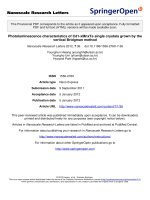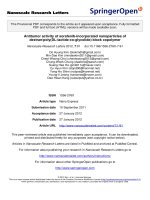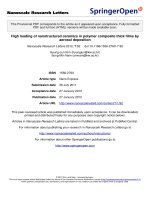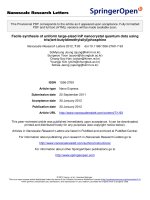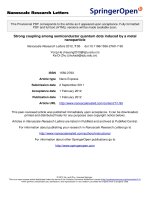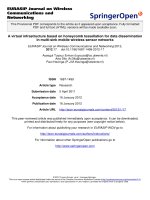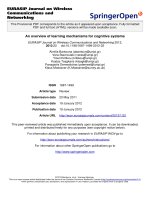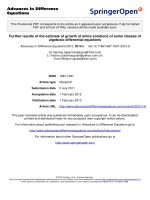Báo cáo toán học: " Inert coupling of IRDye800CW to monoclonal antibodies for clinical optical imaging of tumor targets" potx
Bạn đang xem bản rút gọn của tài liệu. Xem và tải ngay bản đầy đủ của tài liệu tại đây (1.15 MB, 13 trang )
ORIGINAL RESEARCH Open Access
Inert coupling of IRDye800CW to monoclonal
antibodies for clinical optical imaging of tumor
targets
Ruth Cohen
1
, Marieke A Stammes
1
, Inge HC de Roos
1
, Marijke Stigter-van Walsum
1
, Gerard WM Visser
2
and
Guus AMS van Dongen
1*
Abstract
Background: Photoimmunodetection, in which monoclonal antibodies [mAbs] are labeled with fluorescent dyes,
might have clinical potential for early detection and characterization of cancer. For this purpose, the dye should be
coupled in an inert way to mAb. In this study, different equivalents of IRDye800CW, a near-infrared fluorescent dye,
were coupled to
89
Zr-labeled cetuximab and bevacizumab, and conjugates were evaluated in biodistribution
studies. Radiolabeled mAbs were used to allow accurate quantification for assessment of the number of dye
groups that can be coupled to mAbs without affecting their biological properties.
Methods:
89
Zr-cetuximab and
89
Zr-bevacizumab, containing 0.5
89
Zr-desferal group per mAb molecule, were
incubated with 1 to 10 eq IRDye800CW at pH 8.5 for 2 h at 35°C, and
89
Zr-mAb-IRDye800CW conjugates were
purified by a PD10 column using 0.9% NaCl as eluent. HPLC analysis at 780 nm was used to assess conjugation
efficiency. In vitro stability measurements were performed in storage buffer (0.9% NaCl or PBS) at 4°C and 37°C and
human serum at 37°C.
89
Zr-mAb-IRDye800CW conjugates and
89
Zr-mAb conjugates (as reference) were
administered to nude mice bearing A431 (cetuximab) or FaDu (bevacizumab) xenografts, and biodistribution was
assessed at 24 to 72 h after injection.
Results: Conjugation efficiency of IRDye800CW to
89
Zr-mAbs was approximately 50%; on an average, 0.5 to 5 eq
IRDye800CW was conjugated. All conjugates showed optimal immunoreactivity and were > 95% stable in storage
buffer at 4°C and 37°C and human serum at 37°C for at least 96 h. In biodistribution studies with
89
Zr-cetuximab-
IRDye800CW, enhanced blood clearance with concomitant decreased tumor uptake and increased liver uptake was
observed at 24 to 72 h post-injection when 2 or more eq of dye had been coupled to mAb. No significant
alteration of biodistribution was observed 24 to 48 h after injection when 1 eq of dye had been coupled.
89
Zr-
bevacizumab-IRDye800CW showed a similar tendency, with an impaired biodistribution when 2 eq of dye had
been coupled to mAb.
Conclusion: Usage of
89
Zr-mAbs allows accurate quantification of the biodistribution of mAbs labeled with
different equivalents of IRDye800CW. Alteration of biodistribution was observed when more than 1 eq of
IRDye800CW was coupled to mAbs.
Keywords: zirconium-89, monoclonal antibodies, IRDye800CW, cetuximab, bevacizumab
* Correspondence:
1
Department of Otolaryngology/Head and Neck Surgery, VU University
Medical Center, De Boelelaan 1117, P.O. Box 7057, Amsterdam, 1007 MB, The
Netherlands
Full list of author information is available at the end of the article
Cohen et al. EJNMMI Research 2011, 1:31
/>© 2011 Cohen et al; licensee Springer. Thi s is an Open Access article distributed under the terms of the Creative Commons Attribution
License (http://creativecommons .org/license s/by/2.0), which permits unre stricted use, distribution, and reproduction in a ny medium,
provided the original work is properly cited.
Background
Molecular imaging with monoclonal antibodies [mAbs]
harbors a potential for diagnosis and therapy response
evaluation, as well as for the evaluation of molecular
processes in vivo. In addition, it can be used to speed
up and guide mAb development and to tailor therapy
with existing mAbs by providing information about the
targeting performance of mAbs and the expression sta-
tus of cell surface targets. The mAbs labeled with radio-
nuclides can be used for single photon emission
computed tomography [SPECT] or positron-emission
tomography [PET] and are particularly well suited for a
whole-body quantitative imaging of deep-seated tissues.
To this end, we recently introduced clinical immuno-
PET, which is like performing a ‘compreh ensive immu-
nohistochemical staining in vivo’ [1,2]. Procedures were
developed to radiolabel intact mAbs in a clinical good
manufacturing practice [cGMP]-compliant way with zir-
conium-89 (
89
Zr, t
1/2
= 78.4 h) and iodine-124 (
124
I, t
1/2
= 100.3 h), enabling a broadscale clinical application of
immuno-PET [3-6]. Notwithstanding these promising
developments, immuno-PET has a limited resolution.
Photoimmunodetection [PID], in which mAbs are
labeled with fluorescent dyes, might have a complemen-
tary clinical potential to immuno-PET [7-19]. It allows
high-resolution, real-time, dynamic imaging of superfi-
cial tissue layers at the cellular level, without radiation
burden to the patient. Therefore, it might be ideal for
the detection and characterization of an early-stage or
residual disease, for example of cancer during surgery or
in a screening setting. During the past years, the precli-
nical exploration of PID has been boosted by the intro-
duction of more advanced fluorescent dyes, which emit
in the near-infrared [NIR] (approximately 700 to 1,000
nm) region of the spectrum [20]. The advantage of NIR
dyes is that they enable reasonable tissue penetration of
exciting and emitted lights, while the amount of auto-
fluorescence is negligible [21]. Nevertheless, PID is still
waiting for a broadscale clinical application.
The only Food and Drug A dministration [FDA]-
approved NIR fluorophore until now is indocyanine
green [ICG]. It was approved by the FDA in 1958. How-
ever, since the ICG molecule itself cannot be covalently
coupled to mAbs, a mod ifie d version containing an N-
hydroxysuccinimide [NHS] ester-designated ICG-sulfo-
OSu was developed in 1995 by Ito et al. [22]. Although
conjugation o f this ICG dye to proteins appeared facile,
a serious loss of fluorescence was o bserved upon bind-
ing to a protein [22]; albeit with internalizing mAbs, it
might still be applicable [23]. A promising next-genera-
tion NIR fluorophore is IRDye
®
800CW [24]. This NIR
dye can be functionalized with either an NHS or a mal-
eimide reactive group, allowing its attachment to a
broad spectrum of targeting biomolecules. This dye has
been evaluated in several preclinical studies [25-28], but
before being used in clinical investigations, it must
undergo rigorous toxicity testing, the first stage of
which must be conducted in animals. Such studies in
male and female rats revealed no pathological evidence
of toxicity after a single intravenous administration of
IRDye800CW at dose levels of 1, 5, and 20 mg/kg or 20
mg/kg intradermally [29].
a
A prerequisite for using tracer-labeled mAbs in clini-
cal immuno-PET or PID is that the radio nuclide or dye
is coupled to the mAb in an inert way, which means
that the binding characteristics, pharmacokinetics, and
dynamics of the mAb do not become impaired upon
coupling of these tracers. While the stability, binding
characteristics, and in vivo biodistribution of radioim-
munoconjugates can easily and accurately be analyzed in
a quantitative way, t his is much more challenging for
photoimmunoconjugates. This made us decide to use
89
Zr-labeled mAbs as a starting point to facil itate analy-
tical procedures to study, analyze, and quantify the
inertness of dye coupling to mAbs. At a later s tage,
such conjugates might be applied in a multimodal ima-
ging approach, in which PET is used for a low-resolu-
tion whole-body analysis and PID for an additional
local, high-resolution diagnostic evaluation.
For these studies, we selected the US FDA-approved
mAbs cetuximab (Erbitux; Merck, Darmstadt, Germany)
and bevacizumab (Avastin; Genentech, Inc., South San
Francisco, CA, USA/Hoffmann-La Roche Inc., Penzberg,
Germany), directed against the epidermal growth factor
receptor [EGFR] and the vasculature epidermal growth
factor [VEGF], respectively, as the model mAbs. Altered
expressions of EGFR and VEGF are early steps in the
development of many cancers; therefore, these are
appealing targets for early tumor detection by PID. Both
cetuximab and bevacizumab have been tested as radio-
immunoconjugates in combination with
89
Zr in preclini-
cal [30,31] as well as ongoing clinical immuno-PET
studies.
In this study,
89
Zr-labeled cetuximab and bevacizumab
are modified with, on an average, 0.5 to 5 eq of
IRDye800CW per mA b molecule. The integrity and
immunoreactivity of these conjugates are also assessed
afterstorageat4°Cand37°Cinabufferorinhuman
serum at 37°C. In addit ion, comparative biodistribution
and optical imaging studies are presented.
Methods
Materials
The mAb cetuximab (Erbitux; 5 mg/mL) was purchased
from Merck, and bevacizumab (Avastin; 25 mg/mL),
from Hoffmann-La Roche Inc. The human squamous
Cohen et al. EJNMMI Research 2011, 1:31
/>Page 2 of 13
cell carcinoma cel l line A431 was obtained from the
American Type Culture Collection (ATCC number
CRL-15555), and the head and neck squamous cell can-
cer line FaDu, from Karl-Heinz Heider (Boehringer
Ingelheim, Vienna, Austria). IRDye800CW-NHS ester
(MW 1,166 Da, LI-COR Biosciences) was supplied by
Westburg BV, Leusden, The Netherlands.
89
Zr (t
1/2
=
78.4 h) was purchased from IBA Molecular (Louvain-la-
Neuve, Belgium) as [
89
Zr]Zr-oxalate in 1.0 M oxalic acid
(≥ 0.15 GBq/nmol) [32].
Radiolabeling of cetuximab or bevacizumab
Antibody premodification and subsequ ent labeling wit h
89
Zr were performed as described previously, using desf-
eral [Df] (desferrioxamine B, Novartis Pharma BV, Arn-
hem, The Netherlands) as the chelate [33] (see
Additional file 1). When cetuximab was used, it was
buffer-exchanged on a PD10 column (GE Healthcare
Life Sciences, Eindhoven, The Netherlands) to a solution
of 0.9% NaCl before chelate conjugation. Bevacizumab
was used directly from the vial.
Conjugation of IRDye800CW to
89
Zr-mAbs
For the conjugation of IRDye800CW to
89
Zr-cetuxi-
mab/bevacizumab, the solution was brought to pH 8.5
by adding 0.1 M Na
2
CO
3
. Subsequently, 20 μ Lof
IRDye800CW, diluted in dimethyl sulfoxide, was
added, and the total volume was adjusted to 1 mL
with 0.9% NaCl. The IRDye800CW was added to the
mAb solution at a 10:1 to 1:1 molar ratio. The reac-
tion mixture was incubated fo r 2 h at 35°C in a ther-
momixer at 550 rpm. The unreacted dye w as removed
by purification of the conjugates on a PD10 column,
using 0.9% NaCl as eluent. The flow through and t he
first 1.5 mL were discarded. The next 2 mL contain-
ing the conjugated mAb was collected. For a sche-
matic representation of
89
Zr-mAb-IRDye800CW, see
Figure 1.
Analyses
Conjugates were analyzed by instant thin-layer chroma-
tography [ITLC] for radiochemical purity, by high-per-
formance liquid chromatography [HPLC] for mAb
integrity and purity, and by an antigen-binding assay for
immunoreactivity. ITLC analysis was performed on silica
gel-impregnated glass fiber sheets (PI Medical Diagnos-
tic Equipment BV, Tijnje, The Netherlands ), with a 20-
mM citrate buffer of pH 5.0 as the mobile phase. HPLC
analysis was performed on a JASCO Benelux BV HPLC
(de Meern, The Netherlands) with a diode array detec-
tor system and an inline radiodetector (Raytest Isoto-
penmessger äte GmbH, Straubenhardt, Germany) using a
Superdex 200 10/300 GL size exclusion column (GE
Healthcare Life Sciences). The eluent consisted of 0.05
M sodium phosphate/0.15 M sodium chloride plus
0.05% sodium a zide (pH 6.8), and the flow was set at a
rate of 0.5 mL/min. HPLC measurements were per-
formed at A = 280 nm to measure mAb absorption, at
A = 430 nm to measure the absorption of N-sucDf -Fe
(III), and at A = 780 nm to measure the absorption of
IRDye800CW. The chelate-to-mAb and IRDye800CW-
to-mAb molar ratios were determined b y HPLC, u sing
the areas under the curve at A
280
, A
430
, and/or A
780
.
In vitro binding character istics were determined in an
immunoreactivity assay essentially as described before
[30], using A431 cells f ixed with 2% paraformaldehyde
for cetuximab conjugates. For bevacizumab, an enzyme-
linked immunosorbent assay [ELISA] was used, adapted
from Nagengast et al. [31]. Binding data were graphically
analyzed in a modified Lineweaver-Burk (double-reci-
procal) plot, and the immunoreactive fraction was deter-
mined by linear extrapolation to conditi ons representing
infinite antigen excess.
Serum stability test
Serum stability tests were performed with cetuximab/
bevacizumab-IRDye800CW conjugates, with different
Figure 1 Schematic representation of
89
Zr-mAb-IRDye800CW.
Cohen et al. EJNMMI Research 2011, 1:31
/>Page 3 of 13
equivalents of dye coupled to cetuximab/bevacizumab.
Cetuximab/bevacizumab-IRDye800CW and human
serumataratioof1:1(v/v) and 1% sodium azide were
filter-sterilized, mixed, and incubated in a 12-well plate
at 37°C and 5% CO
2
. Control samples were incubated in
sterile phosphate-buffered saline [PBS] instead of human
serum. For analysis of stability, samples were diluted
threefold in PBS prior to HPLC analysis.
Biodistribution
For evaluation of the biodistribution of
89
Zr-cetuximab/
bevacizumab-IRDye800CW and
89
Zr-cetuximab/bevaci-
zumab conjugates, non-tumor-bearing female nude mice
(Hsd athymic nu/nu, 25 to 32 g; Harlan Laboraties BV
CPB, Boxmeer, The Netherlands) as well as mice bear-
ing subcutaneously implanted A431 or FaDu tumors
were used. All animal experiments were performed
according to the Dutch National Institutes of Health
principles of laboratory animal care and Dutch national
law (’Wet op de dierproeven’, Stb 1985, 336).
In a pilot biodistribution study, a total of 16 non-
tumor-bearing mice were injected with 0.31 MBq of
89
Zr-cetuximab-IRDye800CW or
89
Zr-cetuximab or con-
taining, on an average, 1.5, 2.5, or 5.0 eq of dye per
mAb molecule (
89
Zr-cetuximab-IRDye800CW; 1.5, 2.5.
or 5.0 eq). The mice received 100 μg cetuximab in a
total volume of 150 μLintravenously.At24hafter
injection, the mice were anesthetized, bled, euthanized,
and dissected.
In the next biodistribution study with cetuximab, a
total of 60 A431-bearing mice with a tumor size of 168
±75mm
3
were injected with 0.37 MBq of
89
Zr-cetuxi-
mab-IRDye800CW (0.5, 1.0, or 2.0 eq) or
89
Zr-cetuxi-
mab.Themicereceived100μg cetuximab in a total
volume of 150 μL intravenously. At 24, 48, and 72 h
after injection, five mice per group and time point were
anesthetized, bled, euthanized, and dissected. For the
biodistribution study with bevacizumab, a total of 30
FaDu-bearing mice with a tumor size of 600 ± 200 mm
3
were injected with 0.37 MBq of
89
Zr-bevacizumab-
IRDye800CW (1.0 or 2.0 eq) or
89
Zr-bevacizumab. The
mice received 40 μg bevacizumab in a total v olume of
175 μL intravenously. At 24 h after injec tion, blood was
collected from the tail vein of all mice. At 48 and 72 h,
five mice per group and time point were anesthetized,
bled, euthanized, and dissected. The blood, tumor, and
organs were weighed, and the amount of radioactivity
was measured in a g-well counter (Wal lac LKB-Compu-
Gamma 1282; Pharmacia, Uppsala, Sweden). Radioactiv-
ity uptake was measured as the percentage of the
injected dose per gram of tissue [%ID/g]. Differences in
tissue uptake between conjugates were statistically ana-
lyzed for each time point with SPSS 15.0 (SPSS Inc.,
Chicago, IL, USA) using the Student’ s t test for
independent samples. Two-sided significance levels were
calculated, and P < 0.05 was considered statistically
significant.
In vivo fluorescence imaging
NIR images were acquired with the IVIS Lumina system
with indocyanine green filter sets (Caliper Life Science,
Hopkinton, MA, USA), as described before [34]. Data
were analyzed with the Living Image software from
xenogeny version 3.2 (Caliper Life Science). Imaging
time was 1 s.
Results
Production and quality controls of
89
Zr-cetuximab-
IRDye800CW and
89
Zr-bevacizumab-IRDye800CW
On an average, 0.5 group of Df was coupled to cetuxi-
mab or bevacizumab, while labeling with
89
Zr resulted
in an overall la beling yield of 75%. ITLC and HPLC
showed that the radiochemical purity of the product
always exceeded 95% after purification on PD10. Subse-
quent coupling o f IRDye800CW to the radioactive con-
jugate gave conjugation efficiencies of about 50%,
resulting in IRDye800CW-to-mAb molar ratios of 0.5:1
to 5:1, as assessed by HPLC analysis. After purification
on PD10, the dual-labeled conjugate was found to be
more than 99% pure for
89
Zr as well as for
IRDye800CW (Figure 2). The i mmunoreactivity of
89
Zr-
cetuximab was 99% at infinite antigen access and did
not alter when up to 5 eq of IRDye800CW was coupled.
The ELISA binding assay for
89
Zr-bevaci zumab gave a
binding of 75%, which is optimal for this assay, and did
not alter upon coupling of 1 of 2 eq of dye. HPLC ana-
lysis confirmed that there was no d ifference in the con-
jugation efficiency of IRDye800CW to cetuximab/
bevacizumab or
89
Zr-cetuximab/bevacizumab.
89
Zr-
cetuximab/bevaci zumab-IRDye80 0CW conjugates could
be stored in 0.9% NaCl at 4°C for at least 4 days (cetuxi-
mab) or at least 2 days (bevacizumab), without any loss
of integrity and immunoreactivity as asse ssed by HPLC
or binding assay.
Cetuximab and bevacizumab conjugated with, on an
average, 1 to 5 eq of dye were incubated in the presence
of human serum at 37°C and in PBS at 37°C as refer-
ence, and HPLC profiles of the mAb at A
780
were made
to provide information on the physicochemical proper-
ties of the conjugate. None of the conjugates showed
any instability upon storage in PBS for at least 96 h, as
illustrated for cetuximab-IRDye (2.8 eq) in Figure 3A, B.
In human serum, a minimal percentage of IRDye800CW
was released from the antibody: 1.4% to 1.8% for cetuxi-
mab-IRDye (1.5, 2.8, and 4 .8 eq) and 2.8% and 3.5% for
bevacizumab-IRDye (1.1 and 2.2 eq). Besides this, only
minor peak c hanges were observed for both mAbs, as
illustrated for cetuximab-IRDye (Figure 3C, D, E).
Cohen et al. EJNMMI Research 2011, 1:31
/>Page 4 of 13
Biodistribution
To get insight in the relationship between the number
of dyes coupled to the mAb and its pharmacokinetics, a
pilot biodistribution study was performed in non-tumor-
bearing mice. Figure 4 shows the uptake in the blood
and organs of mice injected with
89
Zr-cetuximab or
with
89
Zr-cetuximab-IRDye800CW (1.5, 2.5, or 5.0 eq)
at 24 h after injection. Blood levels were 15.4 ± 1.3, 13.8
±0.8,7.4±0.4,and1.5±0.3%ID/gfor0,1.5,2.5,and
5.0 eq of coupled dye, respectively. Liver uptake
increased with increasing equivalents of dye: 15.3 ± 3.3,
22.2 ± 4.2, 42.9 ± 5.4, and 67.5 ± 10.5%ID/g, respec-
tively. These data indicate that conjugates with 1.5
groups of dye show a tendency of altered biodistribu-
tion, while for conjugates with 2.5 or more groups of
dye, the alteration is evident.
89
Zr-cetuximab-IRDye800CW (0, 0.5, 1.0, or 2.0 eq)
was administered to nude mice bearing A431 tumors
to study the impact of IRDye800CW-to-mAb molar
ratio on the biodistribution, tumor targeting included,
in more detail (Figure 5). Blood levels of
89
Zr-cetuxi-
mab coupled with 0, 0.5, 1.0, and 2.0 eq of dye at 24 h
after injection we re 11.0 ± 1.0, 10.8 ± 1. 6, 8.5 ± 2.6,
and 5.0 ± 1.0%ID/g, respectively (Figure 5A). The
blood clearance of
89
Zr-cetuximab-IRDye (2.0 eq) was
significantly different from that of
89
Zr-cetuximab-
IRDye (0 eq). More rapid blood clearance upon more
coupled groups of dye was accompanied by increasing
liver uptak e (19.8 ± 5.0, 21.3 ± 3.9, 26.1 ± 9.1, and
39.6 ± 5.4%ID/g for 0, 0.5, 1.0, and 2.0 eq coupled,
respectively) and decreasing tumor uptake (22.0 ± 2.2,
20.2 ± 5.0, 20.2 ± 4.8, and 1 3.0 ± 2.4%ID/g, respec-
tively).
89
Zr-cetuximab-IRDye800CW (2.0 eq) also
showed decreased uptake in some of the normal
organs, among which are the skin, tongue, sternum,
heart, lung, and kidney.
At 48 h a fter injection, again, only the
89
Zr-cetuxi-
mab-IRDye (2.0 eq) conjugate showed significant differ-
ences for blood, liver, and tumor uptake compared with
89
Zr-cetuximab-IRDye (0 eq). Overall, blood levels (4.3
Figure 2 HPLC chromatogram of
89
Zr-c etuximab-IRDye800CW (3.5 eq). The upper two channels show the UV absorption of cetuximab at
280 nm and IRDye800CW at 780 nm at a retention time of 26 min. The lower channel represents the radioactive signal of the coupled
89
Zr.
Cohen et al. EJNMMI Research 2011, 1:31
/>Page 5 of 13
± 3.8, 3.1 ± 1.9, 1.6 ± 0.4, and 0.8 ± 0.2%ID/g, respec-
tively), tumor uptake (19.1 ± 6.4, 18.2 ± 7.1, 14.0 ± 3.0,
and 8.1 ± 2.3%ID/g, respectively), and uptake in most
normal tissues were lower than those at 24 h after injec-
tion for all conjugates. Only the liver uptake was slightly
higher for each conjugate at 48 h than at 24 h (27.9 ±
3.2, 25.7 ± 8.4, 29.8 ± 1.9, and 41.8 ± 4.7%ID/g,
respectively; Figure 5B). Blood, tumor, and normal tissue
levels were further decreased at 72 h after injection; only
the liver uptake remained about the same (Figure 5C).
Tumor and liver uptake were significantly different for
conjugates with 2.0 eq compared with those with 0 eq;
levels of blood and of several normal organs were too
low at this time point to be of any statistical value.
Figure 3 HPLC chromatograms of serum incubations of cetuximab-IRDye800CW. HPLC chromatograms at 280 nm (black line, A)andat
780 nm (blue lines, B-E) of cetuximab-IRDye800CW conjugates. Cetuximab-IRDye800CW (2.8 eq) incubated in PBS at 280 (A) and 780 nm (B).
Cetuximab-IRDye800CW coupled with 1.5 (C), 2.8 (D), or 4.8 (E) eq of dye, incubated in serum for 96 h at 37°C days prior to HPLC analysis.
Cohen et al. EJNMMI Research 2011, 1:31
/>Page 6 of 13
The biological effect of the number of dye groups
coupled to a mAb was also studied for
89
Zr-bevacizu-
mab-IRDye800CW (0, 1.0, or 2.0 eq) in a biodistribution
study in nude mice bearing FaDu tumors (Figure 6).
Again, a significantly faster blood clearance was seen
only for
89
Zr-bevacizumab-IRDye800CW (2.0 eq) com-
pared with
89
Zr-bevacizuab-IRDye800CW (0 eq), with
concomitantly significant increased liver uptake at 48 h
(Figure 6A) as well as at 72 h (Figure 6B). Blood levels for
conjugates with 0, 1.0, and 2.0 eq of coupled dye at 48 h
were 12.4 ± 1.6, 10.7 ± 1.7, and 7.8 ± 1.9%ID/g, respec-
tively, while liver uptake was 5.1 ± 0.8, 6.1 ± 1.1, and 13.2
± 1.3%ID/g, respectively (Figure 6A). Tumor values were
not significantly di fferent for conjuga tes containing 0,
1.0, and 2.0 eq of dye: 7.8 ± 0.6, 8.1 ± 1.1, and 7.9 ± 1.7,
respectively at 48 h. At 72 h (Figure 6B), blood levels
were further decreased (8.7 ± 3.4, 8.0 ± 2.6, and 5.6 ±
2.1%ID/g, respectively), and liver values increased (6.2 ±
1.1, 7.8 ± 0.8, and 15.4 ± 4.2%ID/g, respectively). Tumor
uptake did not show significant changes.
Imaging
To confirm selective tumor targeting of the
89
Zr-mAb-
IRDye800CW product with an optical imaging device,
mice injected with the
89
Zr-mAb-IRDye800CW conju-
gates were ima ged 24, 48, and 72 h after injection before
being sacrificed for biodistribution. Figure 7 shows an
example of a mouse injected with
89
Zr-bevacizumab-
IRDye800CW (1.0 eq) 24 h after injection. Tumors were
clearly visualized carrying 6 to 12 pmol of dye as could be
estimated from the
89
Zr tumor accumulation data at 48 h.
Discussion
During the past years, we have developed procedures for
coupling of
89
Zr to mAbs for PET imaging. First clinical
trials have indicated that
89
Zr-immuno-PET might be an
attractive tool for tumor detection and to allow better
understanding of mAb therapy efficacy, more efficient
mAb development, and more patient-tailored therapy
[1,2]. By assuring the inert and cGMP-compliant cou-
pling of
89
Zr to mAbs for human use, FDA-approved
mAbs like cetuximab, bevacizumab, rituximab, and tras-
tuzumab included,
89
Zr-immuno-PET can now be clini-
cally applied in Europe without additional toxicology
studies being required. In a comparable approach, we
now aimed the inert coupling of IRDye800CW to mAbs,
enabling clinical PID as a complementary tool to
radioimmunodetection.
In the present study, we evaluated the impact of the
coupling of different numbers of IRDye800CW mole-
cules to cetuximab and bevacizumab on mAb integrity,
immunoreactivity, a nd in vivo biodistribution. To facili-
tate a quantitative analysis in this study and to open
possibilities for dual modal imaging in future studies,
cetuximab and bevacizumab were labeled with
89
Zr. To
exclude any detrimental effect on the mAbs, just 0.5 Df
group was coupled to the lysine residues of the mAbs,
while our previous studie s rev ealed that at least four Df
groups can be coupled without any impairment of in
vitro and in vivo mAb characteristics. Subsequent cou-
pling of up to five IRDye800CW groups to the lysine
residues of the
89
Zr-mAbs, followed by PD10 purifica-
tion, resulted in conjugates that were more t han 99%
pure for
89
Zr as well as for IRDye800CW, while the
integrity of the mAbs as assessed by HPLC analysis
remained fully preserved. Also, the immunoreactivity
remained preserved under the conditions tested. More-
over, aforementioned
89
Zr-mAb-IRDye800CW conju-
gates remained stable when stored in 0.9% NaCl at 4°C
and in PBS and human serum at 37°C for at least 96 h.
Figure 4 Biodistribution of
89
Zr-cetuximab-IRDye800CW in non-tumor-bearing mice. Biodistribution of intravenously injected
89
Zr-cetuximab
and
89
Zr-cetuximab-IRDye800CW (1.5, 2.5, and 5 eq) in non-tumor-bearing nude mice at 24 h after injection. Data are presented as %ID/g ± SD.
Cohen et al. EJNMMI Research 2011, 1:31
/>Page 7 of 13
Figure 5 Biodistribution of
89
Zr-cetuximab-IRDye800CW in tumor-bearing mice. Biodistribution of intravenously injected
89
Zr-cetuximab
and
89
Zr-cetuximab-IRDye800CW (0.5, 1, and 2 eq) in A431 xenograft-bearing nude mice at 24 (A), 48 (B), and 72 (C) h after injection. Bars
marked with an asterisk have an uptake that is significantly (P ≤ 0.05) different from the uptake of
89
Zr-cetuximab. Data are presented as %ID/g
± SD.
Cohen et al. EJNMMI Research 2011, 1:31
/>Page 8 of 13
Figure 6 Biodistribution of
89
Zr-bevacizumab-IRDye800CW in tumor-bearing mice. Biodistribution of intravenously injected
89
Zr-
bevacizumab and
89
Zr-bevacizumab-IRDye800CW (1 and 2 eq) in FaDu xenograft-bearing nude mice at 48 (A) and 72 (B) h after injection. Bars
marked with an asterisk have an uptake that is significantly (P ≤ 0.05) different from the uptake of
89
Zr-bevacizumab. Data are presented as %ID/
g ± SD.
Cohen et al. EJNMMI Research 2011, 1:31
/>Page 9 of 13
Despite this optimal quality control [QC], an alteration
in the biodistribution of
89
Zr-cetuximab and
89
Zr-beva-
cizumab was observed when more than 1 eq of
IRDye800CW was coupled: blood clearance was faste r,
while liver uptake increased. In the case of cetuximab,
tumor uptake decreased, while this phenomenon was
not observed with bevacizumab. The latter might be due
to the relatively high bevacizumab dose of 40 μg used in
our studies, which might result in antigen saturation
[35]. These data indicate that for clinical PID studies, on
an average, not more than 1 eq of IRDye80 0CW should
be coupled per mAb molecule even when no dual label-
ing with
89
Zr is performed; otherwise, impairment of
mAb biodistribution characteristics might occur. The
mAbs with 1 eq of IRDye800CW coupled showed clear
tumor delineation by optical imaging.
The use of IRDye800CW-labeled mAbs and antibody-
like fragments for tumor detection has been described
in several preclinical studies in mice, but to the best of
our knowledge, n ot in clinical trials thus far
[12,13,19,34,36]. In two of these studies, besides
IRDye800CW,alsoaradioisotopewascoupledtothe
mAb to allow a dual modality optical/nuclear (SPECT
or PET) imaging [12,19]. The inertness of dye coupling
was, however, not quantitatively demonstrated. Sampath
et al. [12] developed and tested a t rastuzumab-based
conjugate containing IRDye800CW as well as indium-
111, which was designated as (
111
In-diethylene triamine
pentaacetic acid [DTPA])
n
-trastuzumab-(IRDye800CW)
m
. On an average, 10 DTPA chelate groups and between
7 and 10 IRDye800CW groups were coupled, far more
than the critical level of 1 dye group as found in our
study. Although the conjugate retained immunoreactiv-
ity in vitro and tumor uptake in vivo, a very high liver
uptake was observed. In a next study of the same group,
a dual-labeled conjugate suitable for PET instead of
SPECT imaging was developed: (
64
Cu-1,4,7,10-tetraaza-
cyclododecane-1,4,7,10-tetraacetic acid [DOTA])
n
-trastu-
zumab-(IRDye800)
m
[19]. This time, 2.4 DOTA groups
and 2.2 IRDye800CW groups were coupled to the mAb.
This conjugate showed good uptake in both primary
and metastatic lesions as demonstrated by PET and
optical imaging, but also this time, high nonspecific liver
uptake was observed 24 h after injection. The authors
propose the high liver uptake to originate from the
interaction of the Fc portion of the antibody with hepa-
tocytes. However, as demonstrated herein, overloading
of the mAb with DOTA chelate and dye groups might
well be the main culprit.
Rapid blood clearance and extensive liver accumula-
tion have also been observed for mAbs coupled with
other chemical groups to t heir lysine residues even
under conditions that did not cause impairment of mAb
immunoreactivity. Coupling of
99m
Tc/
99
Tc-MAG3 or
186
Re-MAG3 chelate groups to lysine residues of a mAb
caused faster blood clearance when, on an average,
more than 8 groups w ere coupled, while immunoreac-
tivity only slightly decreased upon coupling of more
than 12 groups. Concomitantly, a n increased uptake of
the antibody conjugates in the liver and intestines was
observed [37]. For mAbs labeled with
153
Sm via DTPA,
rapid blood clearance and liver accumulation were
observed in rats when 20 chelate groups w ere coupled
permAb[38].Asimilarphenomenonwasobserved
when photoactive dyes were coupled to the mAbs.
Immunoreactivity did not alter when 19 hydrophilic
fluorescein groups were coupled per mAb. However,
upon evaluation of the biod istributio n in mice of mAbs
coupled with 4 to 14 dye groups, coupling of m ore than
10 dye groups per mAb resulted in enhanced blood
clearance [39]. During development of c onjugates for
photoimmunotherapy, upon coupling of the hydropho-
bic photosensitizer meta-tetrahydroxyphenylchlorin
[mTHPC] to lysine residues of mAbs, a twofold higher
liver uptake and a lmost twofold lower tumor and blood
values were observed when just 0.9 mTHPC group was
coupled per mAb molecule, while four mTHPC groups
could be coupled to a mAb without a decrease in
immunoreactivity [40]. These studies clearly show that
depending not only on the number of chelate or dye
Figure 7 Optical imaging with
89
Zr-bevacizumab-IRDye800CW
in a tumor-bearing mouse. NIR image of a nude mouse bearing
FaDu tumors on both lateral sides 24 h after injection of
89
Zr-
bevacizumab-IRDye800CW (1.0 eq). Tumors are indicated with white
arrows.
Cohen et al. EJNMMI Research 2011, 1:31
/>Page 10 of 13
groups, but also on their nature, alterations in hydro-
phobic ity, charge, or conformation might be introduced,
resulting in an altered behavior of the antibody conju-
gates in vivo.
Translating these findings to IRDye 800CW, it seems
that this relatively large molecule (molecular weight
approximately 1,000 Da), having a strongly hydropho-
bic center and three potentially negatively charged
SO
3
H-groups on the outside, apparently induces - via
intramolecular tension - a conformation change of the
mAb molecule. Accordingly, it appears that a mAb
molecule with conformational changes induced by two
dye groups is in vivo ’ recognized’ by the liver as a
denatured mAb and eliminated from the blood/
biocirculation.
Although not the direct purpose of this study,
89
Zr-
mAb-IRDye800CW conjugates can also be used for a
clinical dual modal imaging. To this end,
89
Zr as well
as the IRDye800CW should be coupled in a cGMP-
compliant way t o the mAb. For coupling of
89
Zr to
mAbs, we used a multistep procedure that has been
developed by Verel et al. [33] using a succinylated
derivative of desferrioxamine B (N-sucDf) as a bifunc-
tional chelate. The choice of desferrioxamine B is
attractive because it is used clinically in a safe way for
many years. In addition, several clinical immuno-PET
studies have been performed with
89
Zr-labeled mAbs
[1-4]. A shortcoming of the N-sucDf-based la beling
procedure, however, is that it is relatively time-con-
suming and complicated; therefore, it is challenging
with respect to cGMP compliancy. Recently, the newly
developed p-isothiocyanatobenzyl derivate of desfer-
rioxamine B (Df-Bz-NCS) was introduced, which pro-
vides an efficient and rapid preparation of
89
Zr-mAbs.
Df-Bz-NCSaswellasIRDye800CWarecommercially
available at a cGMP quality. In complementary experi-
ments for the production of
89
Zr-mAb-IRDye800CW,
we have shown that (1) mAb-IRDye800CW conjugates
containing just 0.5 Df group per mAb can efficiently
be labeled with
89
Zr at levels of at least 74 MBq/mg,
which is sufficient for clinical imaging; (2) Df-Bz-NCS
is equally well efficient for
89
Zr-labeling as N-sucDf,
while procedures are more facile; and (3) since the N-
sucDf route requires a pH 4.0 and 9.5 step with this
chelate,
89
Zr labeling has to be performed prior to
IRDye800CW coupling, while for Df-Bz-NCS, the
sequence of conjugation and labeling is not critical.
Altered expressions of EGFR and VEGF are early steps
in the development of many cancers. Therefore, these
are appealing targets for early photodetection of tumor
cell clusters arising in the epithelial linings as well as for
detection of small, established tumor nodules, which
cannot be identified by current radiolo gical and nucl ear
techniques. Therefore, in the pre sent study, cetuximab
(anti-EGFR) and bevacizumab (anti-VEGF) were used as
the model mAbs. At our institute, PID with
IRDye800CW-mAbs will be particularly explored as
molecular probes for tumor detection in endoscopic
procedures [41], using optical coherence tomography for
obtaining structural information [42].
Conclusion
This study describes the coupling of different equivalents
of IRDye800CW to
89
Zr-labeled cetuximab and bevacizu-
mab and the evaluation of the conjugates in biodistr ibu-
tion and optical imaging studies. All c onjugates showed
optimal immunoreactivity and were > 95% stable in sto-
rage buffer at 4°C and 37°C and in human serum at 37°C
for at least 96 h. Alteration of biodistribution was observed
when more than 1 eq of IRDye800CW was coupled to the
mAbs; therefore, conjugation of not more than one dye
group per mAb is recommend ed for clinical PID studies
to assure inertness of coupling.
Additional material
Additional file 1: Additional methods. Description of the radiolabeling
of cetuximab/bevacizumab with
89
Zr and the immunoreactivity assay for
89
Zr-bevacizumab(-IRDye800CW).
Acknowledgements
This project was financially supported by the European Union FP7,
ADAMANT. The publication reflects only the authors’ views. The European
Commission is not liable for any use that may be made of the information
contained.
Endnotes
a
Together with the filing of a Drug Master File at the US FDA, an Active
Substance Master File has been filed with the Dutch regulatory authorities in
support of an Investigational Medical Product Dossier filed for an IRDye
800CW-labeled targeted agent. Data from these studies will enable the filing
of investigational new drug applications for beginning clinical exploration of
the dye.
Author details
1
Department of Otolaryngology/Head and Neck Surgery, VU University
Medical Center, De Boelelaan 1117, P.O. Box 7057, Amsterdam, 1007 MB, The
Netherlands
2
Department of Nuclear Medicine & PET Research, VU University
Medical Center, De Boelelaan 1117, P.O. Box 7057, Amsterdam, 1007 MB, The
Netherlands
Authors’ contributions
IHCdR and MAS performed the labeling and conjugation experiments and
the QC analyses. MSvW performed all animal studies. RC coordinated and
executed all the experiments and drafted the manuscript. GWMV reviewed
the experimental data and manuscript. GAMSvD designed and coordinated
the study and reviewed all the data and the manuscript. All authors read
and approved the final manuscript.
Competing interests
The authors declare that they have no competing interests.
Received: 26 September 2011 Accepted: 1 December 2011
Published: 1 December 2011
Cohen et al. EJNMMI Research 2011, 1:31
/>Page 11 of 13
References
1. van Dongen GA, Visser GW, Lub-de Hooge MN, de Vries EG, Perk LR:
Immuno-PET: a navigator in monoclonal antibody development and
applications. Oncologist 2007, 12:1379-1389.
2. van Dongen GA, Vosjan MJ: Immuno-positron emission tomography:
shedding light on clinical antibody therapy. Cancer Biother Radiopharm
2010, 25:375-385.
3. Borjesson PK, Jauw YW, Boellaard R, de BR, Comans EF, Roos JC,
Castelijns JA, Vosjan MJ, Kummer JA, Leemans CR, Lammertsma AA, van
Dongen GA: Performance of immuno-positron emission tomography
with zirconium-89-labeled chimeric monoclonal antibody U36 in the
detection of lymph node metastases in head and neck cancer patients.
Clin Cancer Res 2006, 12:2133-2140.
4. Dijkers EC, Oude Munnink TH, Kosterink JG, Brouwers AH, Jager PL, de
Jong JR, van Dongen GA, Schröder CP, Lub-de Hooge MN, de Vries EG:
Biodistribution of 89Zr-trastuzumab and PET imaging of HER2-positive
lesions in patients with metastatic breast cancer. Clin Pharmacol Ther
2010, 87:586-592.
5. Divgi CR, Pandit-Taskar N, Jungbluth AA, Reuter VE, Gonen M, Ruan S,
Pierre C, Nagel A, Pryma DA, Humm J, Larson SM, Old LJ, Russo P:
Preoperative characterisation of clear-cell renal carcinoma using iodine-
124-labelled antibody chimeric G250 (124I-cG250) and PET in patients
with renal masses: a phase I trial. Lancet Oncol 2007, 8:304-310.
6. Jayson GC, Zweit J, Jackson A, Mulatero C, Julyan P, Ranson M,
Broughton L, Wagstaff J, Hakannson L, Groenewegen G, Bailey J, Smith N,
Hastings D, Lawrance J, Haroon H, Ward T, McGown AT, Tang M, Levitt D,
Marreaud S, Lehmann FF, Herold M, Zwierzina H, European Organisation for
Research and Treatment of Cancer Biological Therapeutic Development
Group: Molecular imaging and biological evaluation of HuMV833 anti-
VEGF antibody: implications for trial design of antiangiogenic
antibodies. J Natl Cancer Inst 2002, 94:1484-1493.
7. Gutowski M, Carcenac M, Pourquier D, Larroque C, Saint-Aubert B,
Rouanet P, Pèlegrin A: Intraoperative immunophotodetection for radical
resection of cancers: evaluation in an experimental model. Clin Cancer
Res 2001, 7:1142-1148.
8. Withrow KP, Gleysteen JP, Safavy A, Skipper J, Desmond RA, Zinn K,
Rosenthal EL: Assessment of indocyanine green-labeled cetuximab to
detect xenografted head and neck cancer cell lines. Otolaryngol Head
Neck Surg 2007, 137:729-734.
9. Koyama Y, Hama Y, Urano Y, Nguyen DM, Choyke PL, Kobayashi H: Spectral
fluorescence molecular imaging of lung metastases targeting HER2/neu.
Clin Cancer Res 2007, 13:2936-2945.
10. Rosenthal EL, Kulbersh BD, King T, Chaudhuri TR, Zinn KR: Use of
fluorescent labeled anti-epidermal growth factor receptor antibody to
image head and neck squamous cell carcinoma xenografts. Mol Cancer
Ther 2007, 6:1230-1238.
11. Xu H, Baidoo K, Gunn AJ, Boswell CA, Milenic DE, Choyke PL, Brechbiel MW:
Design, synthesis, and characterization of a dual modality positron
emission tomography and fluorescence imaging agent for monoclonal
antibody tumor-targeted imaging. J Med Chem 2007, 50:4759-4765.
12. Sampath L, Kwon S, Ke S, Wang W, Schiff R, Mawad ME, Sevick-Muraca EM:
Dual-labeled trastuzumab-based imaging agent for the detection of
human epidermal growth factor receptor 2 overexpression in breast
cancer. J Nucl Med 2007, 48:1501-1510.
13. Sampath L, Wang W, Sevick-Muraca EM: Near infrared fluorescent optical
imaging for nodal staging. J Biomed Opt 2008, 13:041312.
14. Withrow KP, Newman JR, Skipper JB, Gleysteen JP, Magnuson JS, Zinn K,
Rosenthal EL: Assessment of bevacizumab conjugated to Cy5.5 for
detection of head and neck cancer xenografts. Technol Cancer Res Treat
2008, 7:61-66.
15.
Wang K, Wang K, Li W, Huang T, Li R, Wang D, Shen B, Chen X:
Characterizing breast cancer xenograft epidermal growth factor receptor
expression by using near-infrared optical imaging. Acta Radiol 2009,
50:1095-1103.
16. Zou P, Xu S, Wang A, Povoski SP, Johnson MA, Martin EW Jr,
Subramaniam V, Xu R, Sun D: Near-infrared fluorescence labeled anti-
TAG-72 monoclonal antibodies for tumor imaging in colorectal cancer
xenograft mice. Mol Pharm 2009, 6:428-440.
17. Xu H, Eck PK, Baidoo KE, Choyke PL, Brechbiel MW: Toward preparation of
antibody-based imaging probe libraries for dual-modality positron
emission tomography and fluorescence imaging. Bioorg Med Chem 2009,
17:5176-5181.
18. Ogawa M, Regino CA, Choyke PL, Kobayashi H: In vivo target-specific
activatable near-infrared optical labeling of humanized monoclonal
antibodies. Mol Cancer Ther 2009, 8:232-239.
19. Sampath L, Kwon S, Hall MA, Price RE, Sevick-Muraca EM: Detection of
cancer metastases with a dual-labeled near-infrared/positron emission
tomography imaging agent. Transl Oncol 2010, 3:307-217.
20. Te Velde EA, Veerman T, Subramaniam V, Ruers T: The use of fluorescent
dyes and probes in surgical oncology. Eur J Surg Oncol 2010, 36:6-15.
21. Frangioni JV: In vivo near-infrared fluorescence imaging. Curr Opin Chem
Biol 2003, 7:626-634.
22. Ito S, Muguruma N, Hayashi S, Taoka S, Bando T, Inayama K, Sogabe M,
Okahisa T, Okamura S, Shibata H, Irimura T, Takesako K, Shibamura S:
Development of agents for reinforcement of fluorescence on near-
infrared ray excitation for immunohistological staining. Bioorg Med Chem
1998, 6:613-618.
23. Ogawa M, Kosaka N, Choyke PL, Kobayashi H: In vivo molecular imaging of
cancer with a quenching near-infrared fluorescent probe using
conjugates of monoclonal antibodies and indocyanine green. Cancer
Research 2009, 69:1268-1272.
24. Tanaka E, Choi HS, Fujii H, Bawendi MG, Frangioni JV: Image-guided
oncologic surgery using invisible light: completed pre-clinical
development for sentinel lymph node mapping. Ann Surg Oncol 2006,
13:1671-1681.
25. Kovar JL, Simpson MA, Schutz-Geschwender A, Olive DM: A systematic
approach to the development of fluorescent contrast agents for optical
imaging of mouse cancer models. Anal Biochem 2007, 367:1-12.
26. Tanaka E, Ohnishi S, Laurence RG, Choi HS, Humblet V, Frangioni JV: Real-
time intraoperative ureteral guidance using invisible near-infrared
fluorescence. J Urol 2007, 178:2197-2202.
27. Tanaka E, Choi HS, Humblet V, Ohnishi S, Laurence RG, Frangioni JV: Real-
time intraoperative assessment of the extrahepatic bile ducts in rats and
pigs using invisible near-infrared fluorescent light. Surgery 2008,
144:39-48.
28. Kovar JL, Volcheck W, Sevick-Muraca E, Simpson MA, Olive DM:
Characterization and performance of a near-infrared 2-deoxyglucose
optical imaging agent for mouse cancer models. Anal
Biochem 2009,
384:254-262.
29. Marshall MV, Draney D, Sevick-Muraca EM, Olive DM: Single-dose
intravenous toxicity study of IRDye 800CW in Sprague-Dawley rats. Mol
Imaging Biol 2010, 12:583-594.
30. Perk LR, Visser GWM, Vosjan MJWD, Stigter-van Walsum M, Tijink BM,
Leemans CR, van Dongen GA: Zr-89 as a PET surrogate radioisotope for
scouting biodistribution of the therapeutic radiometals Y-90 and Lu-117
in tumor-bearing nude mice after coupling to the internalizing antibody
cetuximab. Journal of Nuclear Medicine 2005, 46:1898-1906.
31. Nagengast WB, de Vries EG, Hospers GA, Mulder NH, de Jong JR,
Hollema H, Brouwers AH, van Dongen GA, Perk LR, Lub-de Hooge MN: In
vivo VEGF imaging with radiolabeled bevacizumab in a human ovarian
tumor xenograft. Journal of Nuclear Medicine 2007, 48:1313-1319.
32. IBA Molecular. [ />33. Verel I, Visser GW, Boellaard R, Stigter-van WM, Snow GB, van Dongen GA:
89Zr immuno-PET: comprehensive procedures for the production of
89Zr-labeled monoclonal antibodies. J Nucl Med 2003, 44:1271-1281.
34. Oliveira S, van Dongen GA, Stigter-van WM, Roovers RC, Stam JC, Mali W,
van Diest PJ, van Bergen En Henegouwen PM: Rapid visualization of
human tumor xenografts through optical imaging with a near-infrared
fluorescent anti-epidermal growth factor receptor nanobody. Mol
Imaging 2011.
35. Stollman TH, Scheer MG, Leenders WP, Verrijp KC, Soede AC, Oyen WJ,
Ruers TJ, Boerman OC: Specific imaging of VEGF-A expression with
radiolabeled anti-VEGF monoclonal antibody. Int J Cancer 2008,
122:2310-2314.
36. Gong H, Kovar J, Little G, Chen H, Olive DM: In vivo imaging of xenograft
tumors using an epidermal growth factor receptor-specific affibody
molecule labeled with a near-infrared fluorophore. Neoplasia 2010,
12:139-149.
37. van Gog FB, Visser GW, Klok R, van der SR, Snow GB, van Dongen GA:
Monoclonal antibodies labeled with rhenium-186 using the MAG3
Cohen et al. EJNMMI Research 2011, 1:31
/>Page 12 of 13
chelate: relationship between the number of chelated groups and
biodistribution characteristics. J Nucl Med 1996, 37:352-362.
38. Boniface GR, Izard ME, Walker KZ, McKay DR, Sorby PJ, Turner JH, Morris JG:
Labeling of monoclonal antibodies with samarium-153 for combined
radioimmunoscintigraphy and radioimmunotherapy. J Nucl Med 1989,
30:683-691.
39. Pelegrin A, Folli S, Buchegger F, Mach JP, Wagnieres G, van den Bergh H:
Antibody-fluorescein conjugates for photoimmunodiagnosis of human
colon carcinoma in nude mice. Cancer 1991, 67:2529-2537.
40. Vrouenraets MB, Visser GW, Stewart FA, Stigter M, Oppelaar H, Postmus PE,
Snow GB, van Dongen GA: Development of meta-
tetrahydroxyphenylchlorin-monoclonal antibody conjugates for
photoimmunotherapy. Cancer Res 1999, 59:1505-1513.
41. van der Pas MH, van Dongen GA, Cailler F, Pelegrin A, Meijerink WJ:
Sentinel node procedure of the sigmoid using indocyanine green:
feasibility study in a goat model. Surg Endosc 2010, 24:2182-2187.
42. Evans CL, Rizvi I, Hasan T, de Boer JF: In vitro ovarian tumor growth and
treatment response dynamics visualized with time-lapse OCT imaging.
Opt Express 2009, 17:8892-8906.
doi:10.1186/2191-219X-1-31
Cite this article as: Cohen et al.: Inert coupling of IRDye800CW to
monoclonal antibodies for clinical optical imaging of tumor targets.
EJNMMI Research 2011 1:31.
Submit your manuscript to a
journal and benefi t from:
7 Convenient online submission
7 Rigorous peer review
7 Immediate publication on acceptance
7 Open access: articles freely available online
7 High visibility within the fi eld
7 Retaining the copyright to your article
Submit your next manuscript at 7 springeropen.com
Cohen et al. EJNMMI Research 2011, 1:31
/>Page 13 of 13

